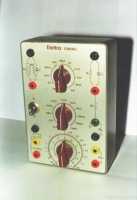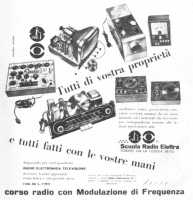|
Provacircuiti Scuola Radio Elettra - Torino - Italia 1955÷1965 |
 |
|
|
| Substitution Circuits Box - Scuola Radio Elettra - Torino - Italy 1955÷1965 |
|
Provacircuiti Scuola Radio Elettra - Torino - Italia 1955÷1965 |
 |
|
|
| Substitution Circuits Box - Scuola Radio Elettra - Torino - Italy 1955÷1965 |
|
Il prova circuiti a sostituzione contiene 15 resistenze fisse, con valori da 75 Ohm a 3 MOhm che possono essere collegate in serie e in parallelo per formare molte combinazioni, e un potenziometro con valore variabile da 0 a 110 kOhm. Il Box contiene anche 6 condensatori con valori fissi da 500 pF a 16 MF, i quali possono essere utilizzati singolarmente o in serie/parallelo oppure, opportunamente combinati con le resistenze, diventano dei filtri RC. Con il Box si possono ottenere 66 tipi di filtri passa basso oppure passa alto e inoltre, collegando i componenti in modo diverso si ottengono 100 tipi di attenuatori a rapporto fisso e 5 a rapporto variabile. In unione ad un tester e con un'alimentazione esterna (da 6.3 a 12 Vac) è possibile utilizzare il Box come ponte di Wheathstone per misurare di impedenze di filtro sino a 30 henry. I primi esemplari del Box erano forniti con un un mobiletto di bachelite nera con il pannello frontale di alluminio dipinto di nero, manopole nere e con le serigrafie bianche. In seguito lo strumento venne fornito con il mobiletto di plastica grigia, con il pannello frontale chiaro, con manopole rosse e con le scritte nere come l'esemplare in mio possesso. Il circuito elettrico del modello nuovo era pressoché uguale a quello della versione iniziale ma i collegamenti tra i vari elementi erano realizzati su circuito stampato. © IK3HIA, 2006 - 2023 |
|||||
 |
 |
 |
|||
 |
 |
 |
|||
|
The replacement circuit tester contains 15 fixed resistors, with values from 75 Ohms to 3 MOhms which can be connected in series and parallel to form many combinations, and a potentiometer with variable values from 0 to 110 kOhms. The Box also contains 6 capacitors with fixed values from 500 pF to 16 MF, which can be used individually or in series/parallel or, suitably combined with the resistors, they become RC filters. With the Box it is possible to obtain 66 types of low-pass or high-pass filters and furthermore, by connecting the components in different ways, we can get 100 types of attenuators with fixed ratio and 5 with variable ratio. Together with a tester and with an external power supply (from 6.3 to 12 Vac) it is possible to use the Box as a Wheathstone bridge to measure filter impedances up to 30 Henry. The first examples of the Box were supplied with a black bakelite cabinet with a black painted aluminum front panel, black knobs and with white screen printing. Later the instrument was supplied with a gray plastic cabinet, with a clear front panel, with red knobs and with black lettering like the example in my possession. The electrical circuit of the new model was almost the same as that of the initial version but the connections between the various elements were made with a printed circuit. © IK3HIA, 2006 - 2023 |
|||||

|
 |
 |
|||
|
|||||
|
Torna a inizio pagina
|
|||||
| Return to IK3HIA home page | Return to Instruments page |